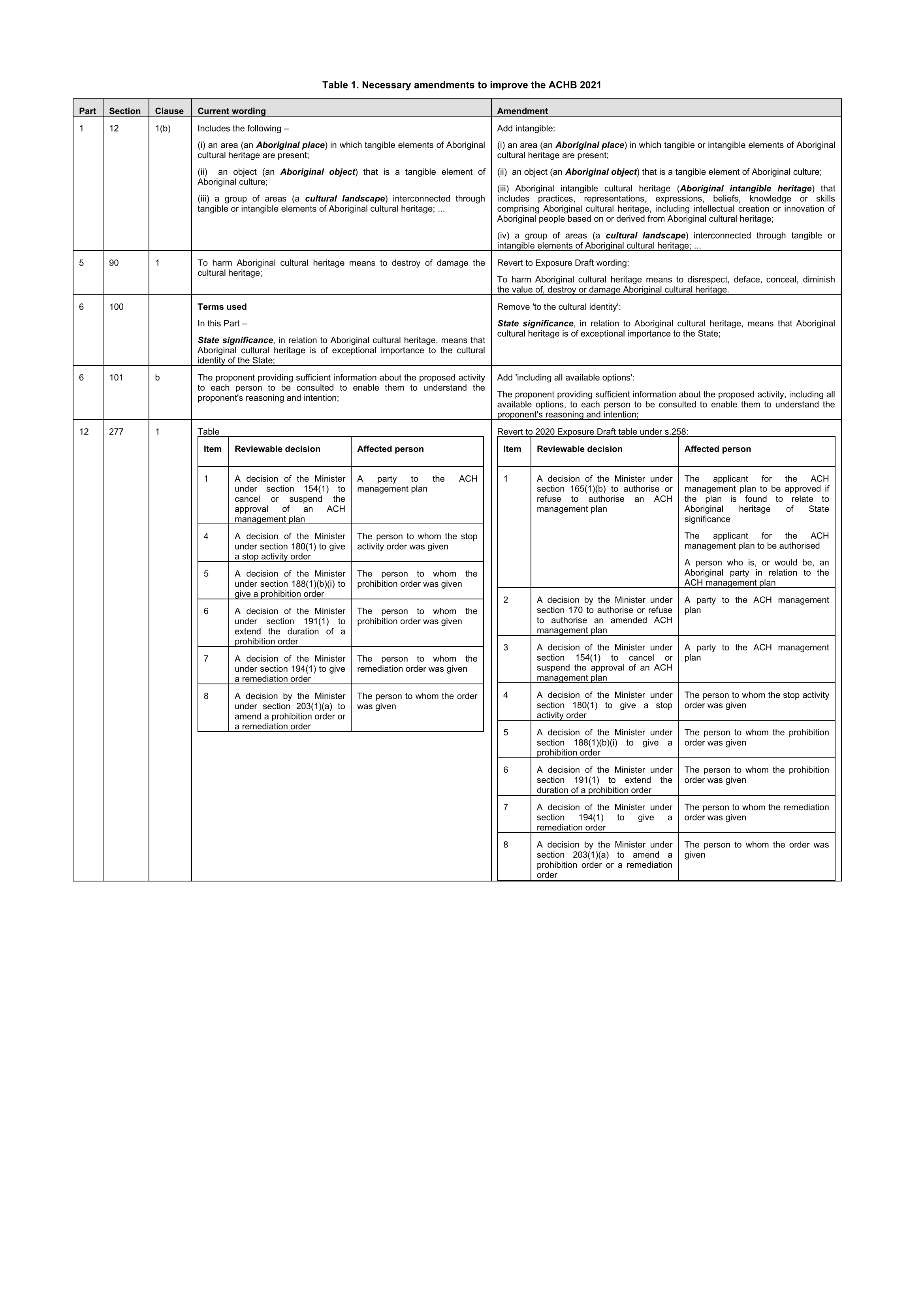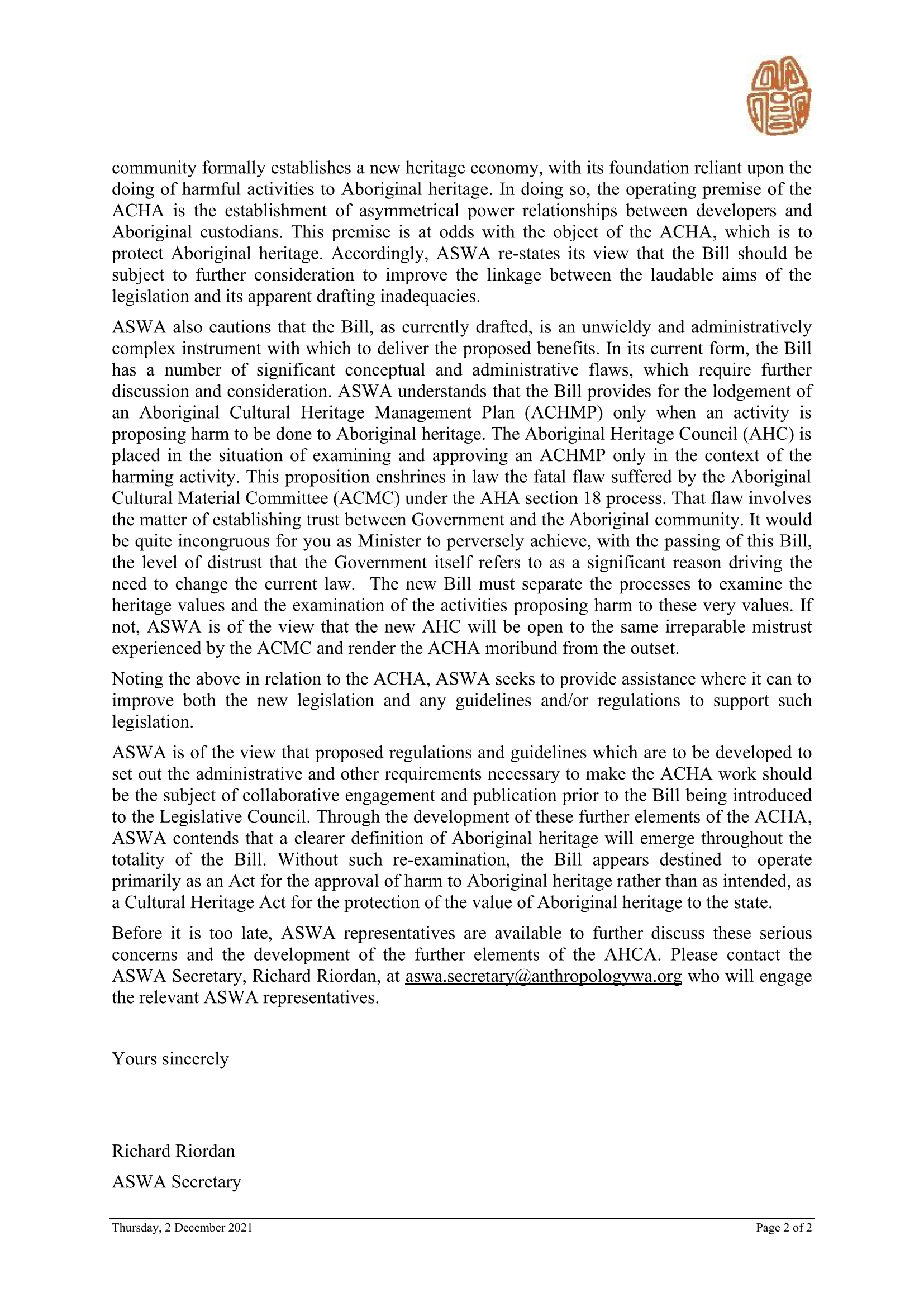Proposed reforms to the Aboriginal Heritage Act 1972 (AHA)
The Aboriginal Cultural Heritage Bill was introduced to Parliament on 17 November 2021 Aboriginal Cultural Heritage Bill 2021 (www.wa.gov.au). We are concerned that points raised in our submission in September, when we were invited to review the draft Bill, do not appear to have been adequately considered. The letter below is our response to the Hon. Stephen Dawson MLC, Minister for Aboriginal Affairs. The letter further down is from our colleagues at the Australian Association f Consulting Archaeologists Inc. (AACAI).


28th September 2021
Dear Minister
The Anthropological Society of Western Australia (ASWA) welcomes the opportunity to comment on the consultation draft of the proposed Aboriginal Cultural Heritage Bill 2020 (Bill). ASWA also welcomes the opportunities provided to it throughout the consultation and drafting process.
ASWA understands that the core premise of the Bill is that whilst it provides for harm to be done to Aboriginal cultural heritage, it provides the right for Aboriginal people to make agreements in respect of the benefits accrued from the doing of such harm. The provision of such rights is a point of difference in comparison to the existing Aboriginal Heritage Act 1972 (AHA).
ASWA respects this self-determination premise of the Bill. However, ASWA cautions that the Bill effectively converts land upon which Aboriginal cultural heritage exists to a value proposition, with amounts measured by the exigencies of situational circumstances. The forced transition, under the Bill, of land defined by cultural tradition to a tradable commodity to provide for ‘balance’ in the recognition of value to the State and broader community formally establishes a new heritage economy, with its foundation reliant upon the doing of harmful activities upon Aboriginal heritage. The formal establishment of this economy, while potentially providing future economic benefits to Aboriginal people, rests on decisions about an ever diminishing range of Aboriginal cultural heritage places and landscapes.
ASWA also cautions that the Bill, as currently drafted, is an unwieldy and administratively complex instrument with which to deliver the proposed benefits. In its current draft, the Bill has a number of significant conceptual and administrative flaws, which require further discussion and consideration. One example is that the Bill provides for the lodgement of an Aboriginal Cultural Heritage Management Plan (ACHMP) only when an activity is proposing harm to be done to Aboriginal heritage. The Aboriginal Heritage Council (AHC) is placed in the situation of examining and approving an ACHMP only in the context of the harming activity. This proposition enshrines in law the fatal flaw suffered by the Aboriginal Cultural Material Committee (ACMC) under the AHA section 18 process. The new Bill must separate the examination of the values of the heritage and the examination of the activities proposing harm to the heritage, (which the ACMC did by administrative practice). If not, ASWA is of the view that the new AHC will be open to the same irreparable mistrust experienced by the ACMC.
ASWA considers that the current draft contains considerable ambiguity in regard to the use of key terms and words. For example, at section 10(1), the word "area" is used to describe the extent of an Aboriginal place. This use is limited to the elements of heritage that make an 'area' a defined Aboriginal place. At section 97(1), the word "area" can be interpreted as being the general geographical extent of a proposed low impact activity being undertaken by a proponent within which there may be many Aboriginal places or “areas”. Alternatively, in section 97(1) the word "area" can be interpreted as being limited to the low impact activity to be undertaken only within the extent of the area that is an Aboriginal place. Depending on the interpretation, ASWA submits that the legal responsibility of the proponent is different and this confusion has effect throughout the other provisions of the Bill, such as the development of an ACHMP. Clarity around this concept is a critical matter which requires addressing throughout the entirety of the Bill.
ASWA draws the Minister's attention to the range of exempt activities that are included in section 90(a) to (j). There appears to be significant latitude in the opportunity to apply exempt activities to “areas” with the Bill providing defence against offences. For example, at 90(g), the Bill provides that clearing of native vegetation in accordance with a clearing permit granted under the Environmental Protection Act 1986 is an exempt activity. In practice, under current streamlining arrangements between State Government agencies, this means that the Department of Mines, Industry Regulation and Safety (DMIRS) when approving a Mining Proposal under the Mining Act 1978 will also be the government agency issue the clearing permit in relation to the mining project. It appears incongruous that by virtue of intragovernmental administrative arrangements a government department can both issue an authorisation for an activity and also issue an authorisation exempting the proponent from offences against the Aboriginal heritage harmed in the activity. As just one example, ASWA is concerned that the Bill, as currently drafted, requires further consideration in the context of the concurrent operation of other State and Federal regulatory and statutory instruments, including Agreements under the Government Agreements Act 1979.
ASWA supports the increase in penalties foreshadowed by the Bill. However, ASWA is of the view that the Bill should include provision for the imprisonment of a representative of a body corporate, for example, a Chief Executive Officer or a Board Chairperson, as it already does for individuals who cause serious harm to Aboriginal cultural heritage. ASWA contends that the inclusion of such provision in the Bill will motivate tangible beneficial behaviours at corporate levels.
The current drafting includes a number of terms and phrases which may be impossible to practically administrate and may lead to significant litigation and delay. For example, at 34(2)(e), the term “impartial” is used in reference to a legal requirement in relation to a person seeking to be appointed as a Local ACH service, with that requirement being adjudicated by the ACH Council. There are other words and terms used throughout the Bill such as "sufficient", "necessary", "comprehensive", "satisfies" and "higher level", yet there is little guidance as to the adjudication method, frame of reference, specified meaning or how these terms will be interpreted during the administrative processes set out in the Bill. ASWA cautions against the use of what could be considered by some as contentious terminology that appears to be readily open to litigation and suggests that where possible these terms are eliminated from the final Bill.
ASWA notes that at section 9, the definition of a landholder is provided through the Heritage Act 2018, section 6. The definition in section 6 excludes holders of mining tenure where the tenure is held under the Mining Act 1904, where the tenure is granted through a State Agreement or where tenure is held under mineral rights to owner arrangements. ASWA has not taken legal advice on this matter, but this definition may perversely mean that major iron ore, bauxite and coal companies in WA that hold tenure under the Mining Act 1904 will by definition not be landholders under the Bill, and as such the undertaking of harmful activities on significant portions of the State may not require legal access to the land. ASWA suggests that this is incongruous, as it appears to provide that under this form of drafting the Minister is able to give approval to a person to undertake activities harmful to Aboriginal heritage on land without the person requiring legal access to the land. If that is the case, then “proponents” and the newly identified category of actor: "person in control over the activity" (section 176(2) & section 180(2)(b)), appear not to need legal access to land in order to undertake harmful activities. ASWA submits that the current definition of landholder is a significant flaw in the drafting of the Bill and recommends that the broader matter of landowner and legal access to land be addressed in the final version of the Bill.
In section 173, the term “remediate” is defined by using the word "remediate". The draft definition is circular and thus confusing. ASWA contends that this definition fails to accommodate cultural and ritual practices related to the repair of physically damaged places. The term “remediate” appears to focus on the "tangible" carrying out of work on land. If this is a “cultural” heritage Act, its drafting needs to reflect “cultural” restorative processes which may be in-tangible, and happen over time, and not just those that emphasise physical / tangible “works”. Since the Bill derives its definition of “land” from the Land Administration Act 1997, not from Aboriginal cultural heritage tradition, the Bill lacks the cultural foundation upon which to recognise the role of cultural ritual in the remediation of harmed places. ASWA recommends that the final version of the Bill re-examine the importance of defining “land” from a culturally appropriate perspective. With such re-examination, ASWA contends that a clearer definition of Aboriginal heritage will emerge throughout the totality of the Bill. Without such re-examination, the Bill will operate as a Land Administration Act for Aboriginal Heritage rather than as intended, as a Cultural Heritage Act for the protection of the value of Aboriginal heritage to the State.
At this juncture, it is suggested that further consideration be given to the drafting of the Bill to improve the legislation which aims to provide a form of rights for Aboriginal people to manage Aboriginal cultural heritage. ASWA contends that as currently drafted, a number of aspects of the Bill’s intent will be blurred by poorly drafted law. ASWA would be pleased to discuss the above and other matters at the Minister's convenience.
Yours sincerely
ASWA Committee


